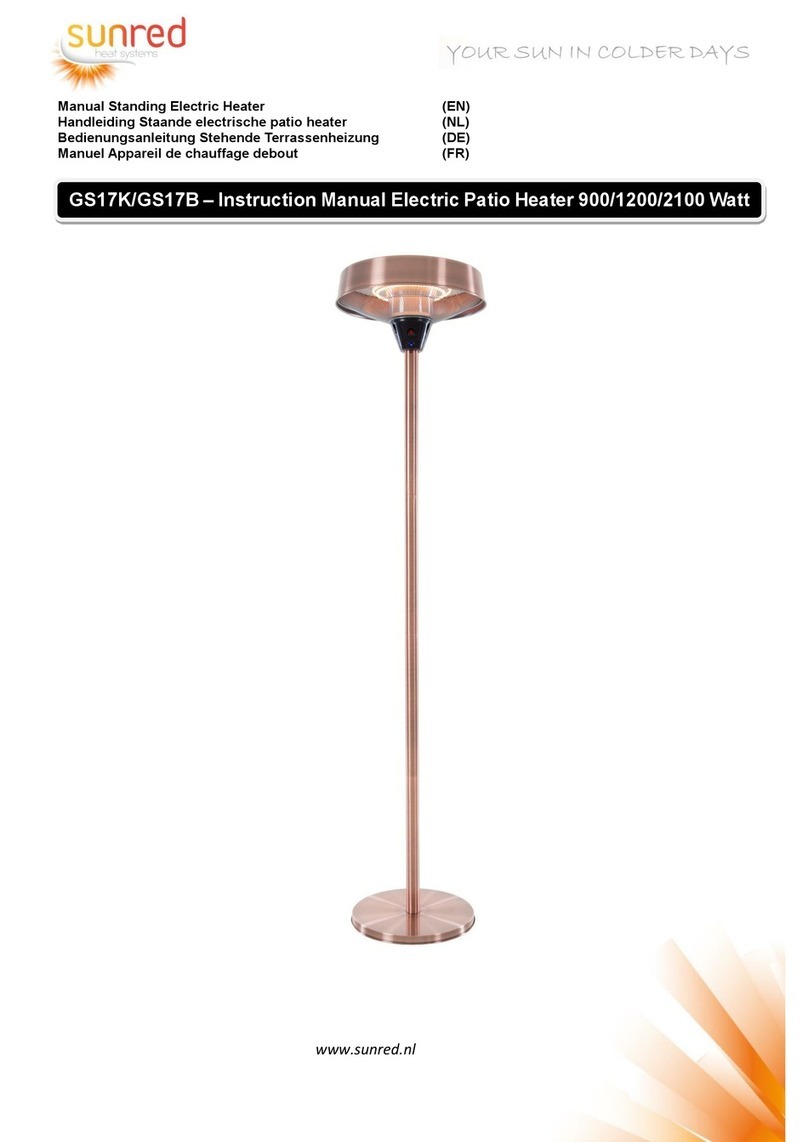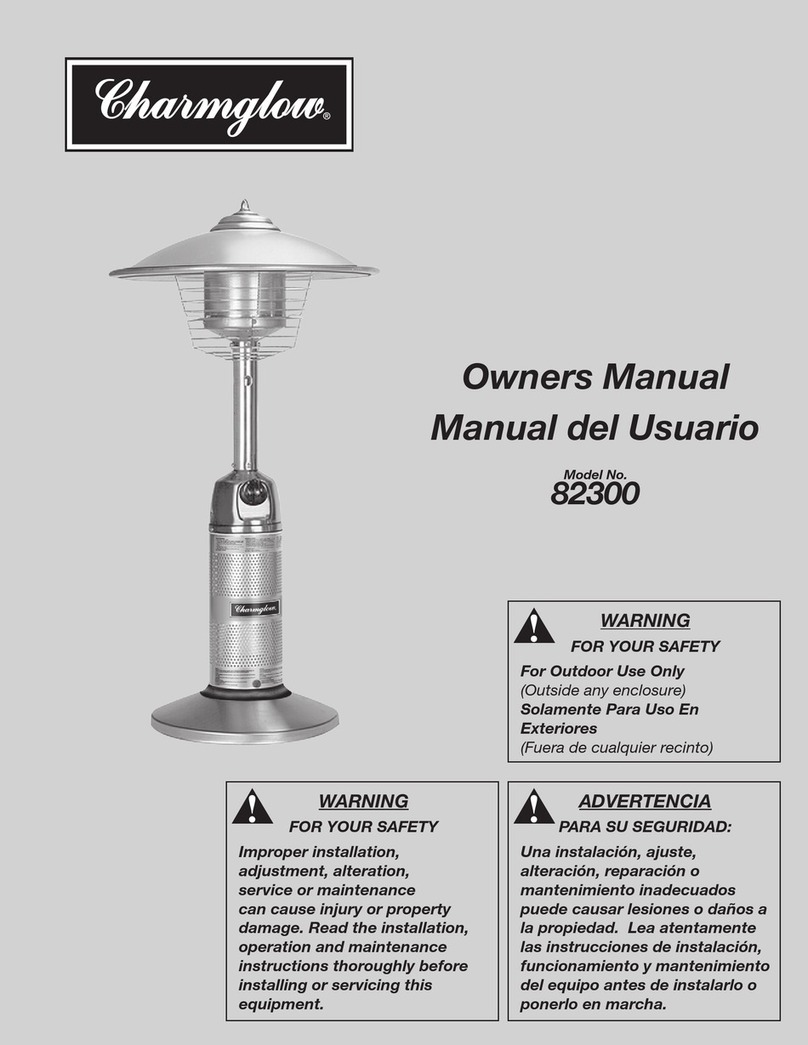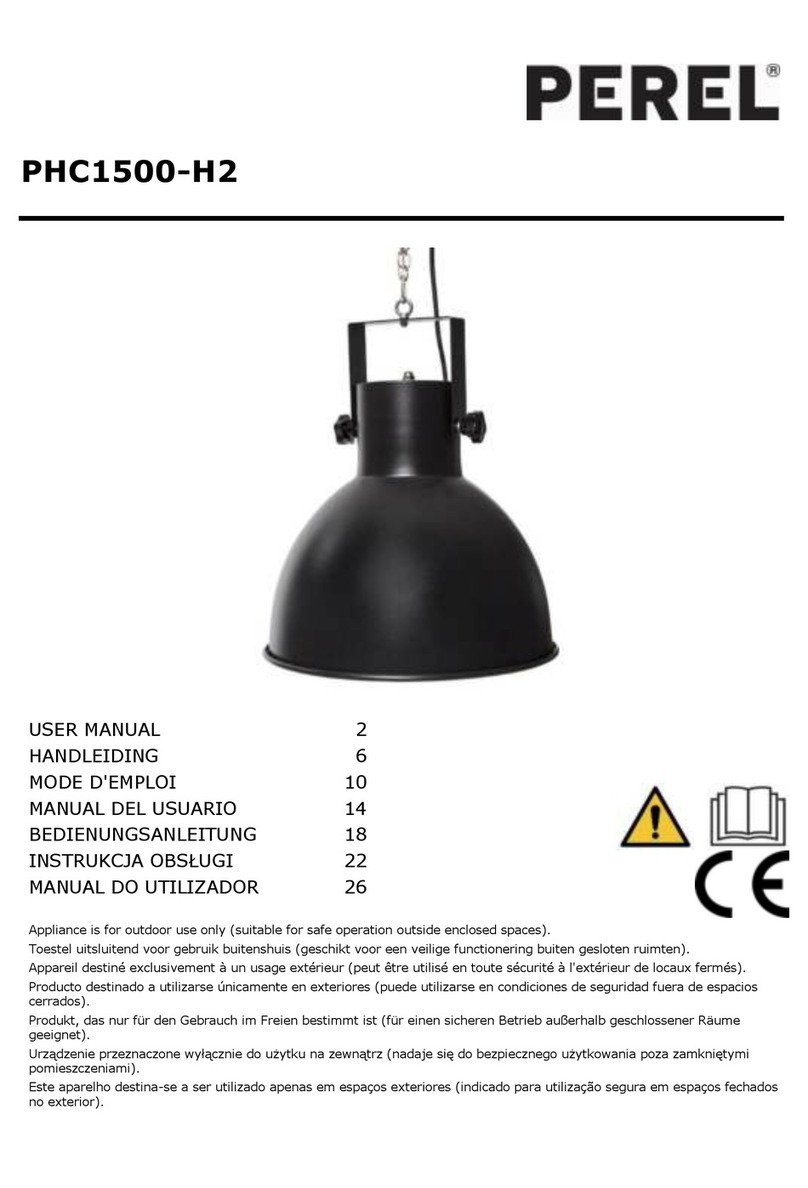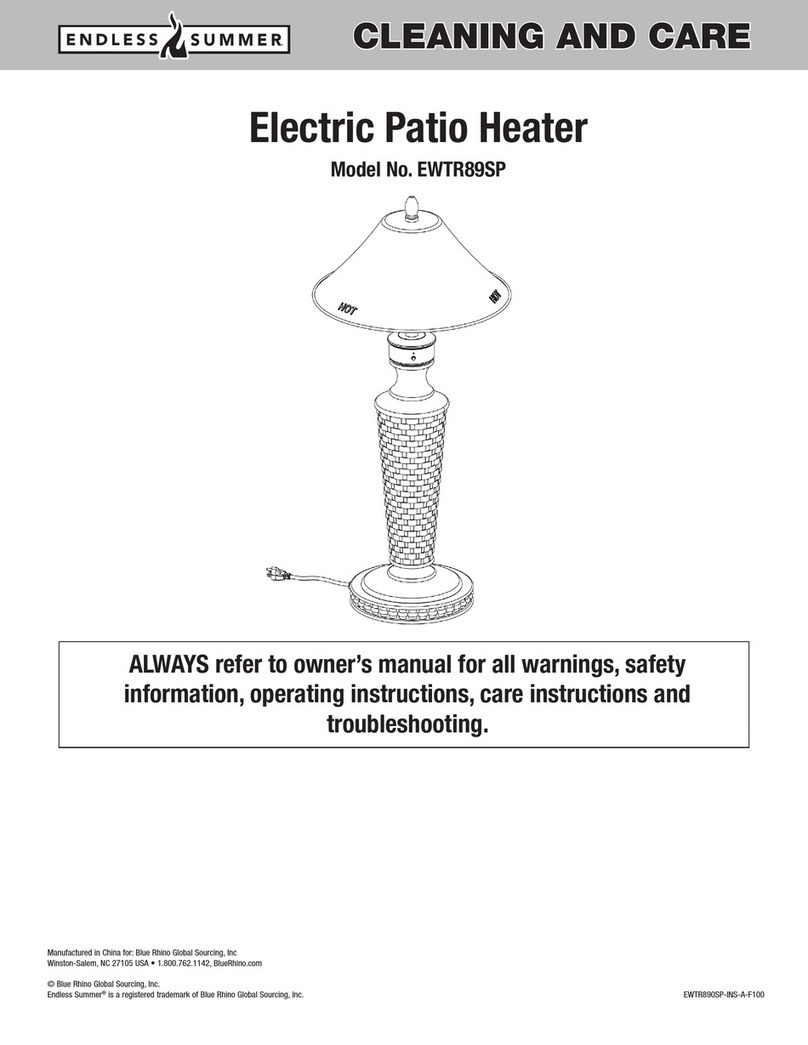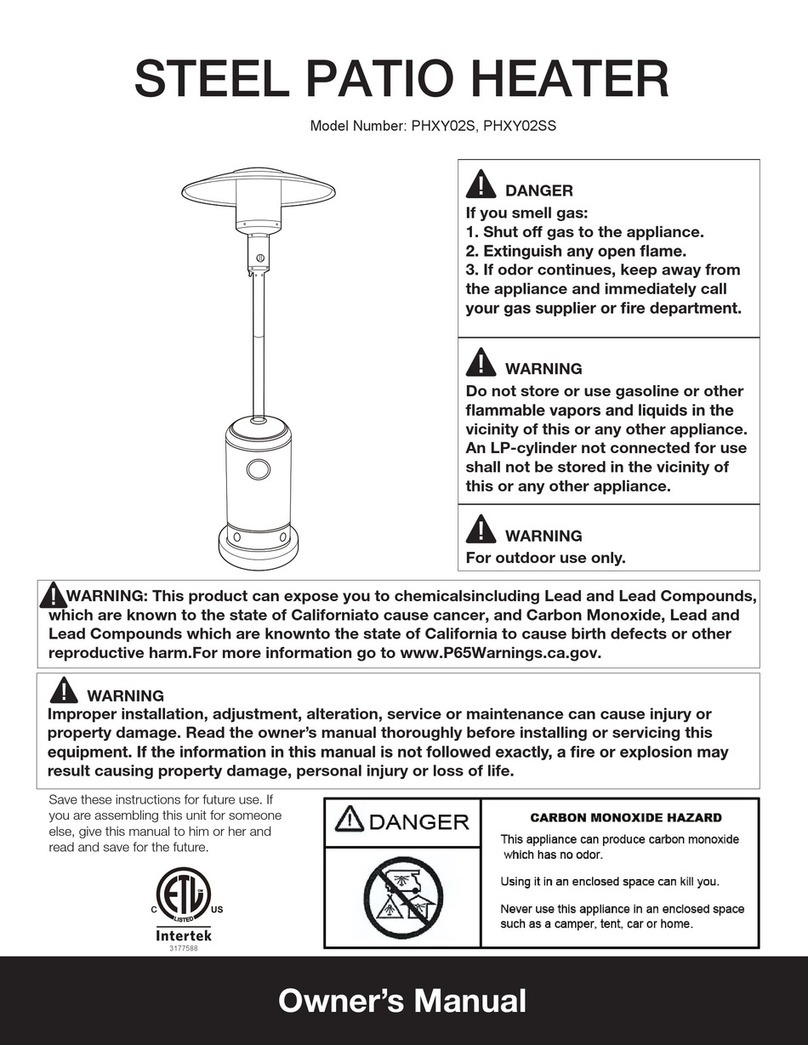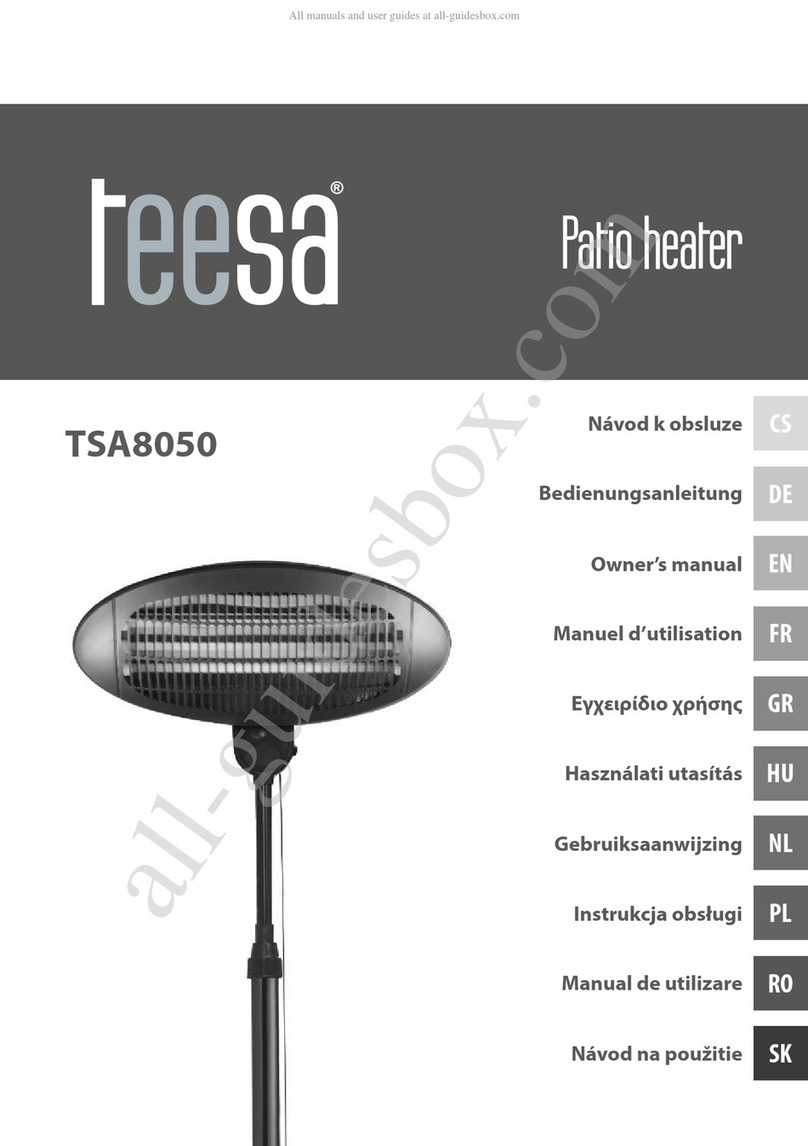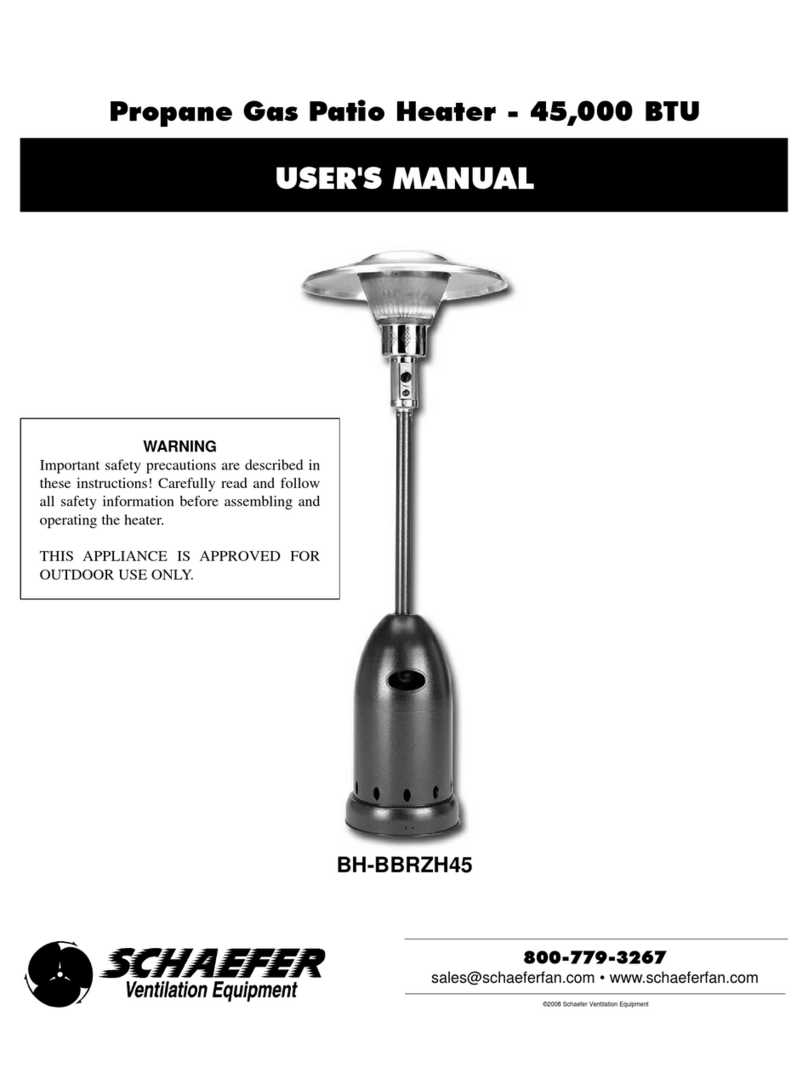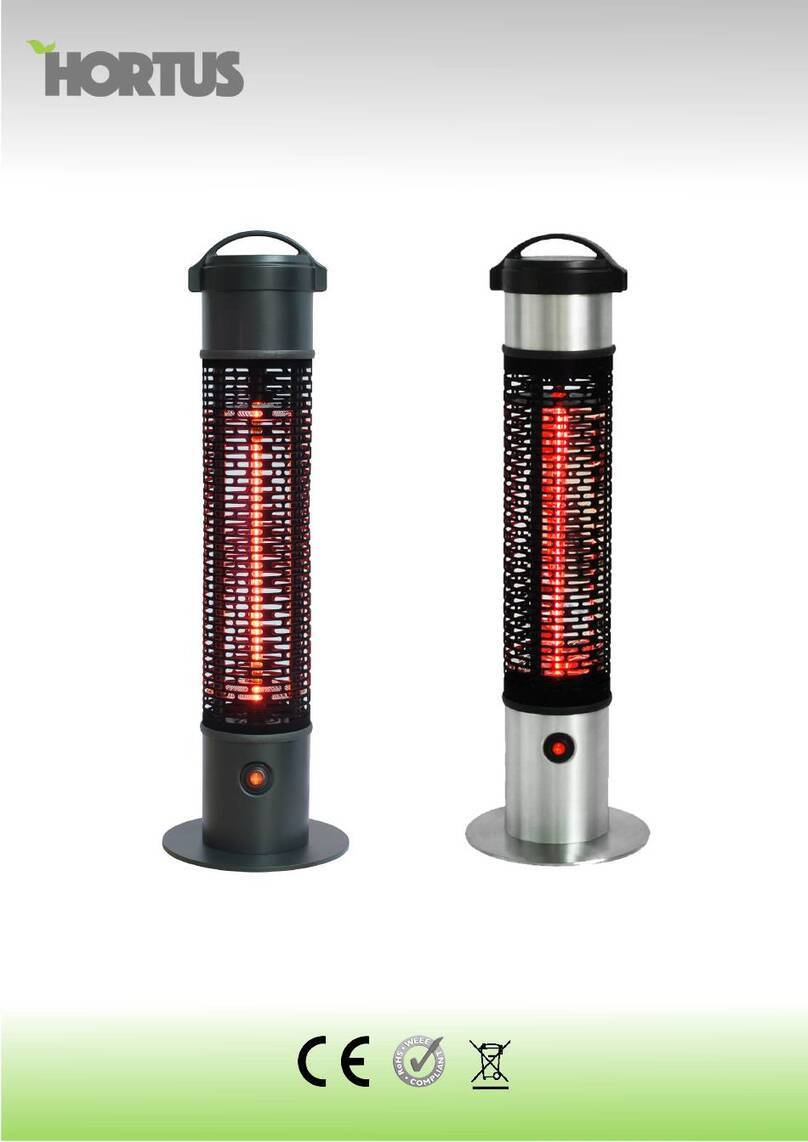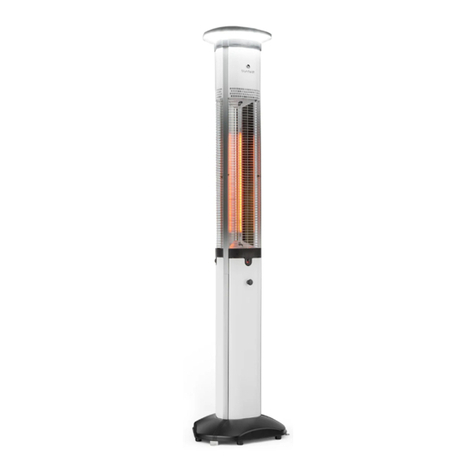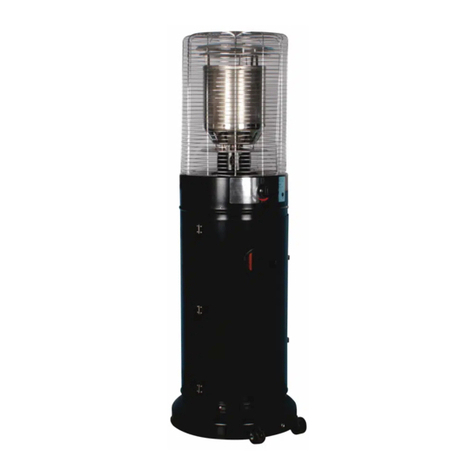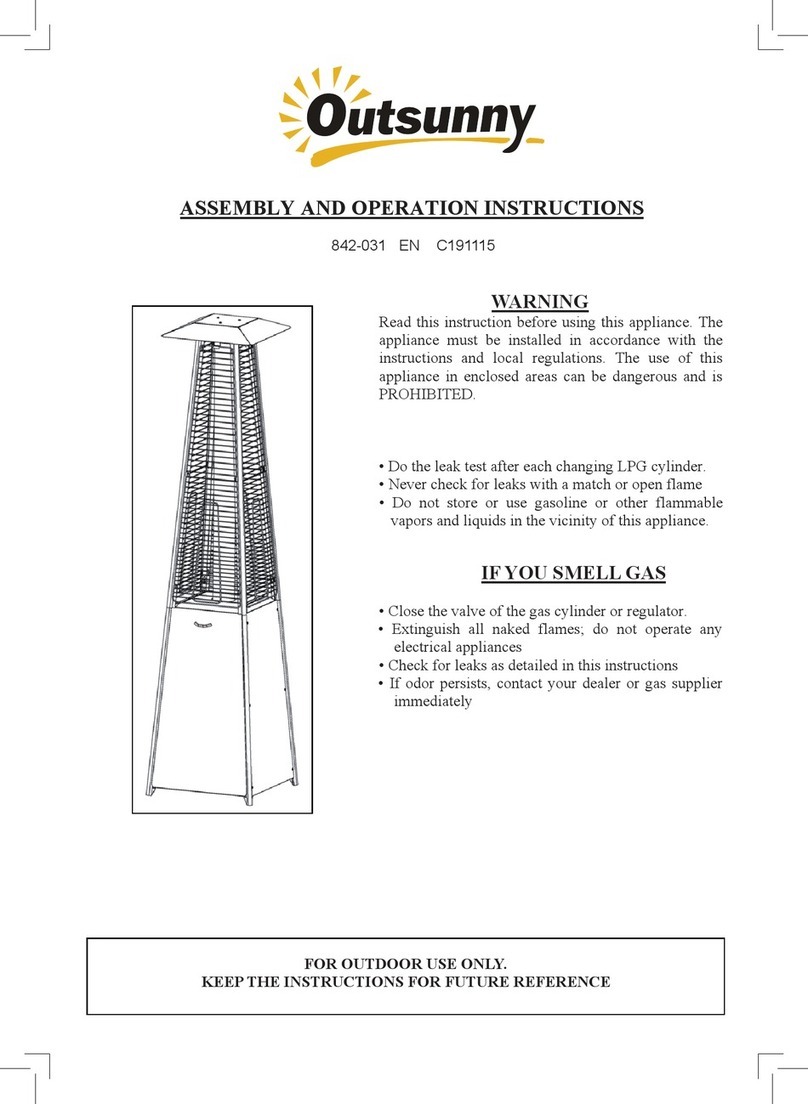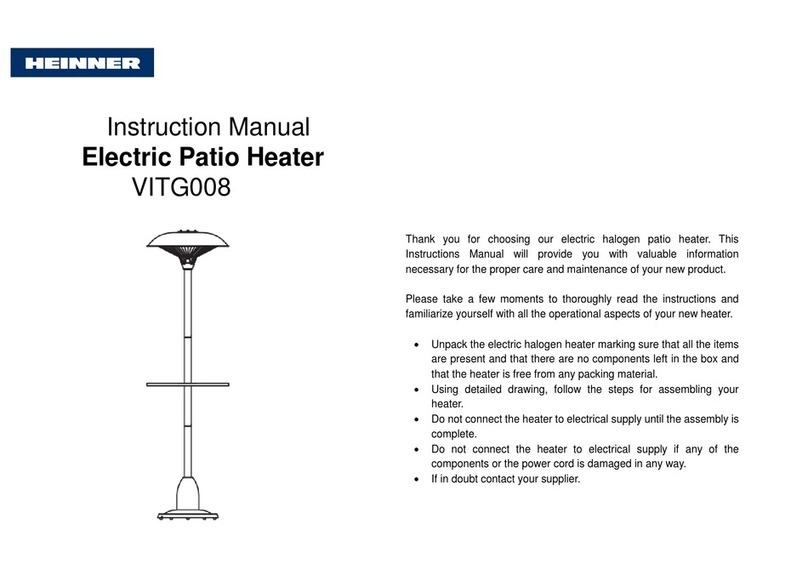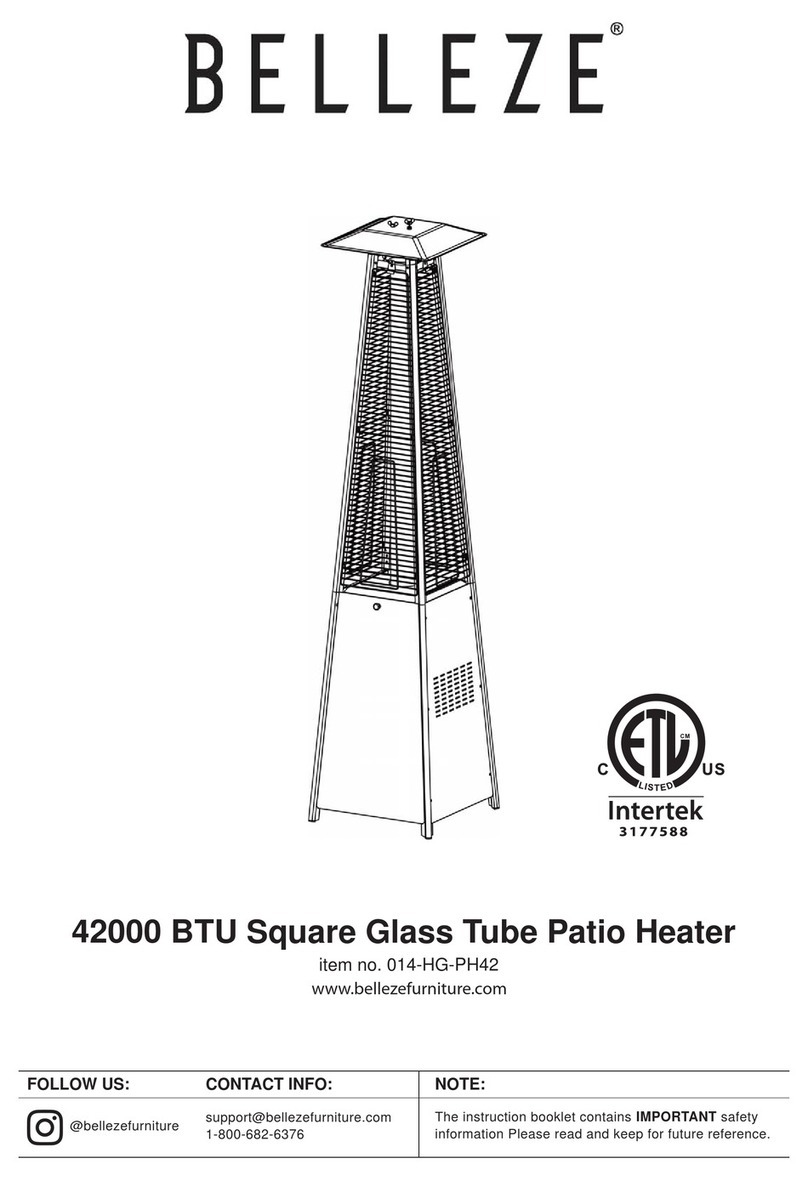Clarke PHT2 Installation and operation manual

PATIO HEATER
OPERATING & MAINTENANCE
INSTRUCTIONS 0201
MODEL No. PHT2

Thank you for purchasing this CLARKE PATIO HEATER.
WARNING!
It is MOST IMPORTANT that ANYONE attempting to use this apparatus
read this booklet thoroughly beforehand and carefully follow the
instructions given.
This will ensure their safety, and that of others around them.
Additionally, you can look forward to the heater giving you long and
satisfactory service.
GUARANTEE
This CLARKE product is guaranteed against faulty manufacture for a period of 12 months from the date
of purchase. Please keep your receipt as proof of purchase. This guarantee is invalid if the product is
found to have been abused or tampered with in any way, or not used for the purpose for which it was
intended.
Faulty goods should be returned to their place of purchase, no product can be returned to us without
prior permission.
This guarantee does not effect your statutory rights.
2

FEATURES
Patio Heaters are portable radiators, simple, highly efficient and reliable, whose functions are based
on the principle of reflected heat.
Wide areas can be heated depending upon atmospheric conditions. These models can be used
outdoors or indoors if the room is large enough and has a constant supply of fresh air.
Patio Heaters are suitable for an environment with a volume of at least 200 m3
Patio Heaters do not expel exhaust gas, non-polluting liquid gas fuel is used (Propane). This heater
complies with current European directives and standards.
The heater is provided with an analyser which switches off the heater when a high level of harmful
substances is detected.
The Heaters are fitted with the following safety devices
a. THERMOELECTRIC PROTECTION:
The pilot flame heats an element that, when heated, keeps the gas tap of the heater open (NOT THE
ONE ON THE CYLINDER). Within one minute of the pilot flame being extinguished, the gas supply is shut
off from the heater tap.
b. AUTOMATIC CO2SENSOR
Automatic closing of the pilot flame and therefore the heater gas tap when the level of CO2exceeds
the limit of 1.5%.
C. PIEZOELECTRIC LIGHTING:
Undoubtedly the safest method of lighting, i.e., no naked flame is required.
SAFETY PRECAUTIONS
WARNING:
The room in which the heater is used must be WELL VENTILATED. This means that
there must be permanent openings in the walls of the room itself (these openings must comply
with current national standards regarding dimensions and position)
• Patio Heaters MUST NOT be used in homes, offices and similar environments.
• NEVER MAKE ANY MODIFICATIONS to the heater.
• Patio Heaters can be installed in rooms with a volume of AT LEAST 200 M3, PER HEATER
• MAKE SURE that there is no flammable material within 2M of the heater
• MAKE SURE that all other materials are more than 1M from the heater
• PAY ATTENTION to whatever may be above the heater because:
At 30 cm from the hood the temperature is 50°C
At 60 cm from the hood the temperature is 40°C
At 90 cm from the hood the temperature is 30°C
• Any flammable coating must be at least 1M from the reflecting hood of the heater.
• DO NOT TOUCH any part of the heater above the piezo holding pipe (15) ,it could be very hot,
enough to cause serious burns.
• ALWAYS wait at least one hour after switching off the heater completely before touching the
parts above the start button.
• NEVER cover the heater .
• DO NOT START the heater if it is not completely assembled.
3

• To stabilise the heater, ALWAYS use cylinders with an empty weight of not less than 11 kg.
• DO NOT USE the heater when there are strong winds, or secure its base to prevent the possibility of
it tipping over.
• NEVER move the heater when it is lit.
• NEVER move the heater just after switching off, but wait until it is cool.
• REMOVE the gas cylinder from its compartment when the heater is not in use for long periods.
• DO NOT replace the rubber hose (8) with one greater than 1M in length.
• ALWAYS close the gas cylinder valve after use.
• ALWAYS keep a constant check on the heater when it is operating.
• DO NOT KEEP gas cylinder in cellars, basements, stairwells, corridors, underground passages, etc.
• DO NOT EXPOSE the gas cylinder to the sun: if this is necessary, it must be covered.
• KEEP the cylinder away from sources of heat.
• The access panel clamps are provided with a means to secure using a small padlock. We strongly
recommend that a padlock is used at all times, to prevent children from tampering with the gas equipment.
ASSEMBLY (Numbers in brackets refer to items in parts list)
When removing the various components from the packing case, you will notice that the radiating
diffuser (9) is discoloured. This is due to the fact that the heater is fully tested by CLARKE International,
before shipping, and the heat generated causes this discolouration.
4
1. First, lay out the components, on the floor, as shown in Fig.1.
It is important that the panels are
positioned in the manner shown.
2. Having noted the orientation of the side panels, place the base (24) on a raised platform, table or
bench with the rim overhanging the edge of the table or bench, as shown in fig. 2.
3. Position the side panel with the hinge bracket attached so that the hinge bracket (A), is adjacent
to the hole in the base (B), in the manner shown in Fig. 2.
4. Line up the hole in the side panel (C), with that in the base and enter a screw. A second pair of
hands is required to thread on the nut from below (D).
5. Proceed to secure the side panel with two further screws and nuts, but do not fully tighten at this
stage.
6. The second side panel requires the hook to be adjacent to the hole in the base (B). Secure in a
similar manner.
7. Place the conical section on top of, and inside the side panels, with the ‘WARNING’ label facing
the access panel. Secure in place using the screws and self locking nuts provided but do not
tighten fully at this stage.
Fig.1
View looking down on top of the base and
panels as they are laid out
Fig.1 Fig.2

9. Attach the access panel using screws and self locking nuts at the hinge brackets. Tighten sufficiently
so that the panel is capable of opening smoothly and evenly.
Clamp the access panel to the side panel and rock the structure to ensure it is stable and that no
particular component is unduly stressed. When satisfied, gently unfasten the access panel and
tighten all nuts, top and bottom.
5
10. Lower the complete sub-assembly to the floor.
11. Remove the three M8 screws with nuts from the end plate of the stack, (Fig.3), and
the three M6 screws from the oppposite end. Locate the stack over the holes in
the top of the conical cover, and secure with the M8 nuts and screws.
12. Before mounting the burner head on to the stack, remove a nut and a flat washer,
from each of the studs on the crown of the burner unit, leaving a flat washer on
each stud, then lower the burner assembly on to the stack, threading the the hose
(8) with gas regulator (19), down through the stacks’ centre.
13. Line up the holes in the rim of the burner unit tube with those in the stack , and
insert the three M6 screws, previously removed. Tighten securely.
14. Standing on a step ladder or similar, mount the hood on the studs. Replace the flat
washers followed by the nuts and tighten securely.
CAUTION: In the case of replacement, it is important that the screws, washers and nuts fastening
the hood (1) and the screws fastening the radiating diffuser (9), are stainless steel.
CONNECTING THE GAS BOTTLE
1. Unclip the access panel (21) and check condition of the regulator and hose.
2. Screw the regulator into the outlet port on the cylinder and tighten securely.
3. Check that the tap turns easily and that there are no gas leaks, using foam or soapy water...NEVER
use an open flame.
4. Place the cylinder in its compartment and ensure the flexible hose is not stretched or kinked. Replace
the access panel
OPERATION
We recommend that first time starting be carried out in the open air, as fumes are given off due to the
elimination of the protective lubricants.
1. Unclip the access panel and turn ON the gas by turning the tap anticlockwise fully...Secure the
access panel
Fig.3
2. Turn the control knob (6) on the front of the stack fully clockwise to
the “START” position (Fig.4).
NOTE: push the knob inwards slightly in order to turn it.
3. Press the control knob inwards fully for 40-50 seconds then press and
release the start button (5) several times until the pilot flame, viewed
through the window, in the conical protector (13), is lit.
4. Once the pilot flame is lit, wait a further 10-20 seconds before releasing
the control knob.
5. If the pilot light goes out, press the control knob once again and hold
in that position whilst repeatedly pressing the start button.
6. When the pilot light remains ON, push the control knob inwards slightly
(NOT FULLY) and turn it anticlockwise to a suitable position between
Minimum or Maximum (Fig.4), according to the capacity required. It
will take 3-5 minutes before the effects are felt.
Fig.4

SWITCHING OFF
Turn the control knob to the ‘START’ position. To turn OFF the heater completely, remove the access
panel and shut the valve on the gas cylinder by turning the knob clockwise fully.
STORAGE
The heater is constructed from materials to withstand normal weather conditions, however, it is advised
to store under cover for maximum preservation.
If there are problems of space, the reflecting hood (1) can be removed, and the nuts and washers
preserved with care (NB: they are all stainless steel). Remove the cylinder from its compartment. Enclose
the burner unit in a polythene bag and similarly wrap the side covers to prevent the possibility of local
wild life from setting up home...particularly during the summer months..
RESTARTING AFTER STORAGE
IMPORTANT: Ensure the underside of the reflecting hood is as clean as possible.
Remove the radiating diffuser (9), by removing the three screws around the outer band (14), clean
inside and out with an ordinary cloth (DO NOT USE oily products that would produce fumes when the
heater is next switched on).
Remove any cobwebs and dust from the conical protector (13).
Reassemble all the parts.
Check the rubber hose (8) and if cracked or damaged in any way, replace it with a hose of NOT MORE
THAN 1 metre in length.
MAINTENANCE
There are no user serviceable parts for this heater. It is necessary only to keep the various components
clean, particularly the underside of the hood. DO NOT clean the heater when it is lit or only just switched
off. Wait until it has cooled down. Clean using a clean soft cloth.
CHECK annually that the hose (8) connecting the regulator (19) and control valve (7) is in good order:
otherwise, replace it. (see your Clarke dealer)
Any repairs should be made by trained technicians and with original replacement parts. For parts and
servicing, consult your CLARKE dealer.
SPECIFICATIONS
Type of gas Propane
Rated pressure 37mbar
Rated heating capacity 10 KW
Consumption 0.700 kg/h
Part No. White 6920007
Silver 6920009
Black 6920011
Stainless Steel 6920012
Green 6920013
6

PARTS DIAGRAM
7
PARTS & SERVICE TEL: 020 8988 7400
PARTS & SERVICE FAX: 020 8558 3622
or e-mail as follows:
PARTS: Parts@clarkeinternational.com
SERVICE: [email protected]
For Spare Parts and Service,please contact your nearest dealer, or CLARKE International, on one of the following numbers.
SPARE PARTS
1 Reflecting Hood 780 Standard TMR110000
2 Burner TMR120000
3 CO2 Analyser TMR130000
4 Support Rod TMR140000
5 Piezo device TMR131000
6 Control Knob TMR141000
7 Control Valve TMR133000
8 Gas Hose 37 bar TMR136000
9 Radiating Diffuser TMR150000
10 Nozzle 16 TMR137600
11 Diffuser Stand TMR156000
12 Support For Analyser TMR158000
13 Conical Protector TMR159000
14 Outer Band TMR159500
15 Piezo Holding Pipe TMR160000
16 Tap Connection Pipe (2 Pcs.) TMR161000
18 Stack TMR163000
19 Regulator 37 bar TMR136500
20 Over Centre Clamps TMR164000
21 Access Panel TMR165000
22 Conical Section TMR165500
23 Side Panels TMR164500
24 Base TMR166000

This manual suits for next models
5
Table of contents
Other Clarke Patio Heater manuals



